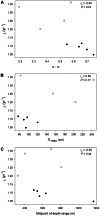Comparative demography of skates: life-history correlates of productivity and implications for management
- PMID: 23741442
- PMCID: PMC3669027
- DOI: 10.1371/journal.pone.0065000
Comparative demography of skates: life-history correlates of productivity and implications for management
Abstract
Age-structured demographic models were constructed based on empirical estimates of longevity and maturity for five deepwater Bering Sea skates to investigate how observed differences in life history parameters affect population growth rates. Monte Carlo simulations were used to incorporate parameter uncertainty. Estimated population growth rates ranged from 1.045 to 1.129 yr(-1) and were lower than those reported for other Alaskan skates and most chondrichthyans. Population growth rates of these and other high-latitude skates increased with relative reproductive lifespan, but displayed no significant relationship with body size or depth distribution, suggesting that assemblage shifts may be difficult to predict for data-poor taxa. Elasticity analyses indicated that juvenile and adult survival had greater per-unit effects on population growth rates than did egg-case survival or fecundity. Population growth rate was affected more by uncertainty in age at maturity than maximum age. The results of this study indicate that if skates are deemed to be a management concern, gear modifications or depth-specific effort controls may be effective.
Conflict of interest statement
Figures





References
-
- Holden MJ (1973) Are long-term sustainable fisheries for elasmobranchs possible? Rapp P-v Réun Cons Int Explor Mer 164: 360–367.
-
- Walker PA, Hislop JRG (1998) Sensitive skates or resilient rays? Spatial and temporal shifts in ray species composition in the central and north-western North Sea between 1930 and the present day. ICES J Mar Sci 55: 392–402.
-
- Dulvy NK, Metcalfe JD, Glanville J, Pawson MG, Reynolds JD (2000) Fishery stability, local extinctions, and shifts in community structure in skates. Conserv biol 14: 283–293.
-
- Frisk MG, Miller TJ, Dulvy NK (2005) Life histories and vulnerability to exploitation of elasmobranchs: inferences from elasticity, perturbation and phylogenetic analyses. J Northwest Atl Fish Sci 35: 27–45.
-
- McPhie RP, Campana SE (2009) Reproductive characteristics and population decline of four species of skate (Rajidae) off the eastern coast of Canada. J Fish Biol 75: 223–246. - PubMed
Publication types
MeSH terms
LinkOut - more resources
Full Text Sources
Other Literature Sources

